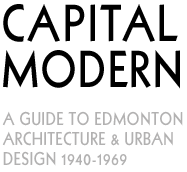Like many cities across Canada, Edmonton has a wealth of Modern architecture that is often under-appreciated locally, but is nationally significant. During the 1950s and 1960s, Edmonton became a leader in modern building due to an oil boom in 1947, which spurred development and created a desire within city planners and businesses to appear both modern and progressive.
This guidebook has been produced to accompany the exhibition, CAPITAL MODERN: Edmonton Architecture and Urban Design: 1940-1969, that was produced by the Art Gallery of Alberta in the summer of 2007. Curated by a team of three local architects, Shafraaz Kaba, David Murray and Troy Smith, the exhibition is an incredible representation of important Modernist buildings that were constructed in Edmonton in the post-war era. The exhibition features a collection of new photographs that were specially commissioned from renowned architectural photographer James Dow. Over the course of 2006 and into 2007, Dow photographed over 50 Modernist buildings for inclusion in the exhibition. These are presented with archival photographs, original drawings and floor plans, furniture and design objects from the period, as well as works of art from the AGA collection, which give a sense of the design ideals and aesthetic ideology of the time.
Arranged chronologically, the exhibition and guide book allow you to take a walk through 30 years of architectural history in Edmonton. Of particular significance is the Legislature Annex Building constructed by Rule Wynn Rule in 1951, which was the first curtain wall building in Canada, completed just after the Lever House in New York City. The 1957 Edmonton City Hall was another example of a leading-edge building. This lozenge-shaped structure pre-dated Ottawa’s City Hall, a building which is well-known for its importance within the history of modern Canadian architecture. The first planetarium in Canada was built in Edmonton in 1960 by City architects Robert Duke and Walter Teifer.

2 Comments